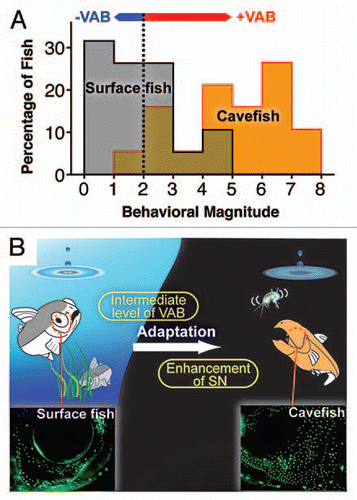Figures & data
Figure 1 A proposed scenario for adaptation to life in caves mediated by VAB. (A) VAB levels in surface fish and cavefish indicated by behavioral magnitude. Behavioral magnitude is the square root of the number of approaches to a vibrating rod (35 Hz) during a 3 min assay period. Surface fish: n = 19, gray area; cavefish: n = 19, orange area. Green area: overlap between surface and cavefish. Vertical dashed line represents the cutoff value for classifying fish with (above 2) or without (below 2) VAB. The red horizontal bar indicates the range of surface fish individuals with an intermediate level of VAB, which dominate over surface fish without VAB in competitive prey capture assays. The blue horizontal bar indicates the range of cavefish individuals without VAB, which are out-competed by cavefish with VAB in prey capture assays. (B) A diagrammatic summary of the enhancement of VAB and SN during adaptation of Astyanax to life in caves. Ovals on the top left and right indicate ripples produced by a dropping object (percolating water), which may contain vibrating prey (indicated in right side above cavefish). Lower parts show neuromasts stained by the fluorescent DASPE I in the cranial regions of surface fish (left) and cavefish (right). Surface fish with intermediate levels of VAB dominate in prey capturing but do not show a large increase of SN. Thus, the first adaptive step is proposed to occur by expressing an intermediate level of VAB, and SN elaboration is suggested to enhance and fine-tune VAB during the second step of adaptation to cave life.
